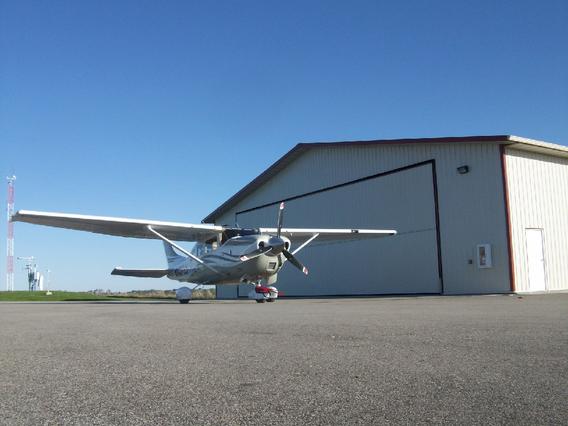
Fillmore County Airport (FKA) is located among the rolling hills and farmland of southeastern Minnesota near the Iowa border, about four miles east of the county seat of Preston and five miles west of the town of Spring Valley.
The airport opened in 1970, with a 3,200-ft. turf strip; that runway was paved and lighted in 1975, then extended to 4,000 feet in 1989. A parallel taxiway was added in 2005 and a new fuel system was installed in 2013. The airport’s arrival/departures building is dedicated to Bernard Pietenpol (1901–1984), a designer of homebuilt aircraft who lived most of his life in nearby Cherry Grove, Minnesota, and who was inducted into the Minnesota Aviation Hall of Fame in 1991.
The airport’s operations consist of general aviation aircraft, with roughly 70 percent for leisure and 30 percent for business purposes, says airport manager Pam Schroeder. With its runway and full parallel taxiway, the airport can accommodate jet and large turbo-prop aircraft for area businesses. Local ethanol plant Poet, for example, conducts weekly, and sometimes more frequent, flights, Schroeder says. Recreational opportunities in the area include major trout streams and the Preston Trout Center, bike trails, cave tours, the Preston Veteran Cemetery, and Forestville State Park. And the airport’s wide-open and somewhat remote location makes it desirable for pilots practicing takeoffs and landings, she says.
Schroeder has been with the Fillmore County Highway Department for 25 years and took on the assigned role of airport manager in 2006. Highway maintenance supervisor Brent Kohn assists Schroeder with daily maintenance operations such as airside and fuel system inspections, navaid operation, NOTAMs, and similar functions. Schroeder credits Kohn’s experience as a pilot in ensuring the safety of other pilots using FKA.
Holding a degree in business management but lacking aviation experience, Schroeder embarked on a “self-taught adventure” in learning to manage the budget and hangar leases, oversee maintenance operations and grant administration, and work with county board members to develop the airport.
“The similarities between highway and airport are intriguing,” she says. “However, the aviation aspect has a number of added details always popping up that are not something a non-career aviation manager would necessarily know. Those details encouraged me to learn more as I go and utilize it to benefit the tenants, transient pilots, the county, and all others involved with FKA.”
Schroeder credits relationships with her consultant, MnDOT, the FAA, MCOA, and AirTAP for helping her learn the ropes and feel supported. “They are a huge voice for aviation and funding and support the success of airports,” she says.

Deters Aviation is the airport’s fixed-base operator, providing flight training, inspections, routine maintenance, and parts. If you fly into the airport, you’re likely to be greeted by owner Isaac Deters and his dog, Diesel, Schroeder says.
Schroeder says many aircraft owners are moving to smaller airports for a better experience. FKA has seen a number of aircraft requesting to base at FKA and has a current waiting list of 10. These pilots prefer the convenience of a smaller airport that is less busy, allowing them more time in the air.
“Regardless of funding struggles, we continue to keep the airport’s airside safety needs satisfied first,” Schroeder says. The airport’s primary focus over the last few years has been airport development, particularly providing more hangar space. All current hangars on the airport are privately owned and at full capacity. The airport is currently in the final stages of completing a Master Plan and Airport Layout Plan (ALP). “That process has given proof and encouragement to plan for a growing GA airport,” she says. She’s hopeful that the airport will be able to start developing an eight-unit T-hangar within the next year.
Like many small airports in Minnesota, Fillmore County Airport may not be on the radar of people who live nearby and never use it. However, the community as a whole receives many indirect benefits, Schroeder says.
“The airport is a positive tool providing economic development for various purposes—too many to mention,” she says. “Transient and based aircraft provide a boost in our local communities for restaurants, hotels, tourism, real estate sales, industrial contracts/meetings, agricultural uses, and more. People fly in all the time for cattle sales, auctions, fly fishing, biking, and day trips to area attractions, all the while spending money within our community.” Finding a way to quantify that economic benefit and spread the word to more people are important goals for Schroeder.
What has made FKA successful, Schroeder says, is the people and policymakers surrounding it—an active group of pilots, the FBO, airport committee members, and a supportive county board. “In talking with other cities and county sponsors, we all agree the success of an airport is provided by the support of commissions and boards,” she adds.

